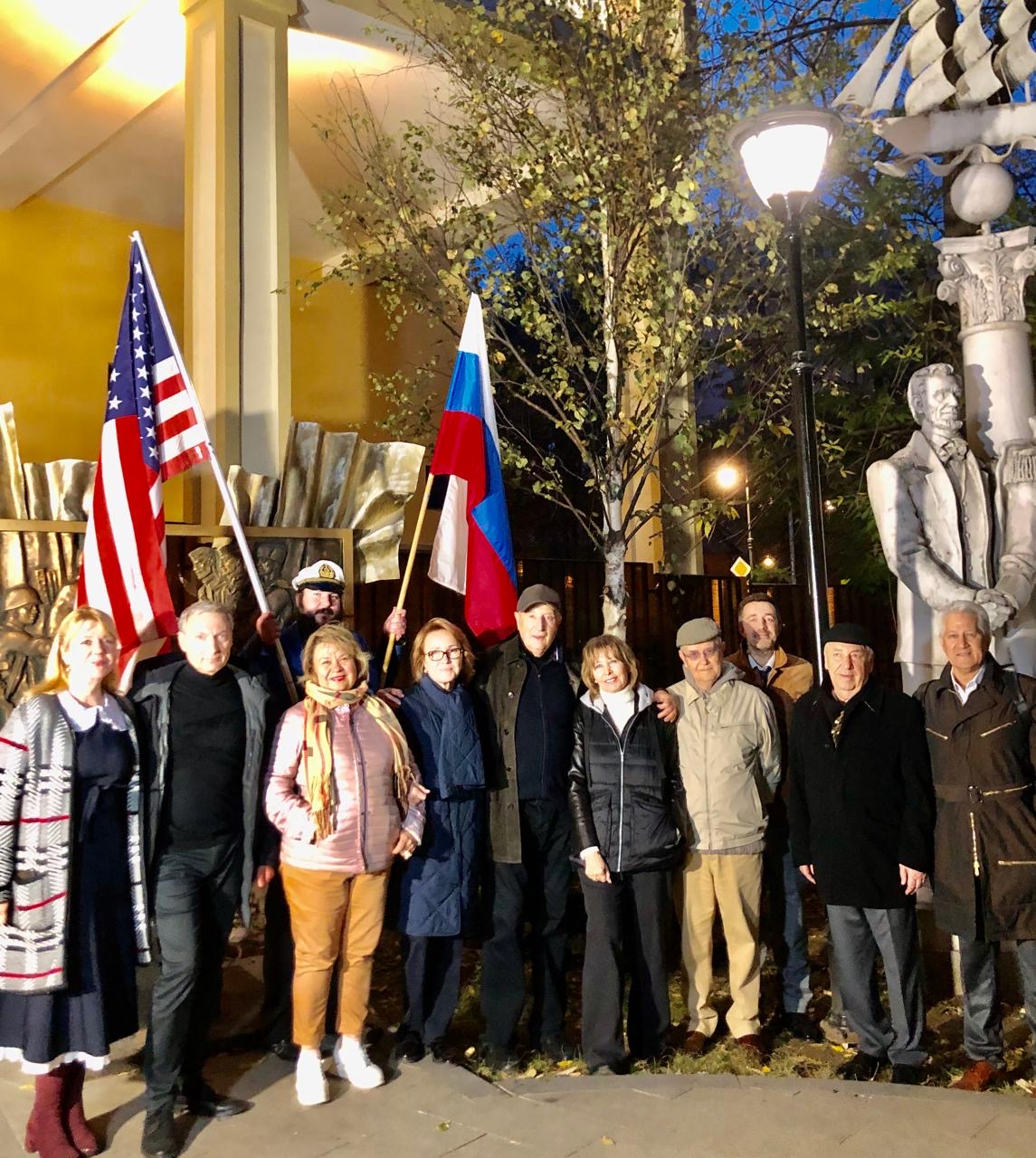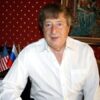In Moscow, a birch tree that’s meant to symbolize U.S.-Russian friendship has several times failed to thrive, as Edward Lozansky recounts. But citizen diplomats keep trying.

The latest peace-tree planting ceremony took place in Moscow on Monday. (Tatiana I. Lozansky)
By Edward Lozansky
 As the drums of war beat louder and the warmongering rhetoric becomes shrill, a group of Russian and American activists assembled in downtown Moscow to replant yet again the symbolic U.S.-Russia friendship birch tree that was initially planted nine years ago.
As the drums of war beat louder and the warmongering rhetoric becomes shrill, a group of Russian and American activists assembled in downtown Moscow to replant yet again the symbolic U.S.-Russia friendship birch tree that was initially planted nine years ago.
It has had to be replaced several times as the trees have struggled to survive. Some say it’s because of the severe weather, and some, with a sense of humor, believe it’s because of a toxic atmosphere between the two countries posioning the tree.
[Related: War in Ukraine & the ‘Crisis of Western Civilization’]
The first one was planted on April 24, 2015, on the eve of the 70th anniversary of the historic “Elbe River” meeting of the American and Soviet military on April 25, 1945, which became symbolic of their joint victory over Nazi Germany.
The ceremony took place with the active participation of the U.S. embassy in Moscow. Then Ambassador John F. Tefft was a diplomat of the old “search for compromise” school, which has since been replaced by “rules-based order” diplomacy, meaning U.S. world leadership, another word for “hegemony.”
Invoking the ‘Elbe Spirit’
His science and cultural attaché, Andrew McLean, had delivered a very emotional speech about the importance of the “Elbe Spirit” for future generations. He was followed by many other dignitaries and guests, including Raymond McGovern, former senior C.I.A. analyst during the Reagan and Bush, Sr. days, who read Russian poetry and sang with the crowd the famous military hit “Katyusha.”
Then, everyone got a shovel to plant the first U.S.-Russia friendship tree.
It was still alive the following year, when on April 25, 2016, next to this tree, the sculptural composition of three American and three Soviet soldiers shaking hands on the bridge of the Elbe River was installed. It was made by the famous Russian sculptor Aleksandr Burganov, whose statue of the greatest Russian poet, Aleksandr Pushkin, is installed on the campus of George Washington University, a few blocks away from the White House and State Department.

General Bruce McClintock, then acting military attache at the U.S. embassy in Moscow, on left side in blue uniform, shaking hands with Russian sculptor Alexander Burganov, who created the monument in background, on April 25, 2016. Also shown are General Peter Zwack, former military attache, and Russian officials and public figures. (Tatiana I. Lozansky)
Ambassador Tefft was still in Moscow in 2016. At the ceremony,the embassy was represented by three U.S. generals who spoke: military attaché Bruce McClintock and two former attaches, Kevin Ryan and Peter Zwack.
McClintock shook hands with Russian cosmonaut Alexei Leonov, who, together with U.S. Astronaut Thomas P. Stafford, was commander of the 1975 joint U.S.-U.S.S.R. Apollo-Soyuz spacecraft.

McClintock at the 2016 event shaking hands with Russian cosmonaut Alexei Leonov, who was on the 1975 Apollo-Soyuz mission. (U.S. embassy)
This was the last time U.S. diplomats took part in subsequent Elbe River ceremonies in the Moscow square that has became known, albeit unofficially, as the “American Corner.”
The U.S. embassy also ignored an invitation to again take part this year, refusing to send even a low-level diplomat for the symbolic act honoring war veterans.
Glimmer of Hope
There had been a glimmer of hope things could be reversed in April 2020, when we decided to bypass the diplomats and shoot for the top by inviting Presidents Donald Trump and Vladimir Putin to participate. It was a long shot, but unexpectedly, we got a positive reply. No, they didn’t appear at the “American Corner” but did issue a joint statement.
Both presidents discussed the importance of the event and ended with encouraging words:
“‘The Spirit of the Elbe’ is an example of how our countries can put aside differences, build trust, and cooperate in pursuit of a greater cause. As we work today to confront the most important challenges of the 21st century, we pay tribute to the valor and courage of all those who fought together to defeat fascism. Their heroic feat will never be forgotten.”
Trump’s critics saw this as additional proof that he was Putin’s stooge, and this was the last time any positive, high-level exchange happened between the two nations.
Nevertheless, in addition to officials, there are also the people’s “diplomats” who understand the critical urgency of the moment and who are trying to send a different message.

Peace rally in Kingston, New York, last Saturday, while Joe Lauria, Consortium News’ editor in chief, was speaking. (Corinna Barnard)
Two days before the tree planting on Monday this week, in Kingston, New York, at the Four Corners of Freedom at Crown and John Streets, Roger Waters, founder of Pink Floyd [in video link]; Judge Andrew Napolitano, host of Judging Freedom podcast; Scott Ritter, former U.N. weapons inspector, columnist; Joe Lauria, editor-in-chief of Consortium News; Gerald Celente, founder of Occupy Peace, and publisher of the Trends Journal magazine; and Randy Credico, comedian, and WBAI radio host, delivered a peace message to the assembled crowd and via Zoom around the world.
In Moscow, Russian and American peace activists assembled at the “American Corner” to replant once again the birch “U.S.-Russia Friendship Tree” and send the same message of peace across the ocean. Passers-by couldn’t believe they saw American and Russian flags waving together as a sign of friendship between the peoples of both nations in these dangerous times.
As Paula Day, president of the Center for Citizen Initiatives, one of the observers of both the Kingston and Moscow events via Zoom, said:
“Given the tenor of our times, these meet-ups feel a bit like what I imagine early Christians experienced as they gathered in small, discrete groupings hoping to avoid being fed to the lions before a ravening crowd in the Coliseum; the more friends, the more strength and courage in numbers.”
Edward Lozansky is president and founder of the American University in Moscow and the U.S.-Russia Forum. He is also a professor at the Moscow State and National Research Nuclear Universities.
The views expressed are solely those of the author and may or may not reflect those of Consortium News.
Please Donate Today to CN’s Fall Fund Drive



* “Awh, the wars they will be fought again. The holy dove, she will be caught, again. Bought & $old; &, bought, again. The dove is never, free. Ring the bells, that still can ring,” i.e., Edward Lozansky’s “recount,”
…..‘In Moscow, a [BIRCH] tree that’s meant to symbolize U.S.-Russian friendship has several times failed to thrive;” [BUT], “citizen diplomats keep trying.” “Nevertheless, in addition to officials, there are also the people’s “diplomats” who understand the critical urgency of the moment and who are trying to send a different message,” Edward Lozansky.
……IMO, i.e., “WHAT practicing “peace” looks like!” IMO, their *“light melts the darkness. Leading, U.S.,” past “ Trump’s critics.” Basically, flying under the MSMedia’s radar, CRUCIAL “Acts of Humanity,” i.e., People, in Kingston, NY, “Rallying For Peace, Freedom, No Nukes!!! People, universally, adverse to Nuclear War!” &, “peace across the ocean, in Moscow, Russian & American peace activists, @ the “American Corner,” replant, once again, [the Sacred BIRCH tree] aka “U.S.-Russia Friendship Tree.”
“It’s our time to make amends. It’s our time to break the rules. Let’s begin!!!” X Ambassadors
…..“The world is filled with countless majestic & awe-inspiring trees, each with its unique story to tell. From ancient mythologies to modern spiritual practices, trees have always held a special place in human culture.” * The Seven Sacred Trees, Oak, Walnut, Cedar, Elder, Yew, Ash, BIRCH.
“The sacred BIRCH tree is a symbol of “NEW” beginnings, resilience, adaptability., i.e., “bereza” is Russian for “birth.”
Concluding, “A Withering Tree of Peace,” is no longer “withering” despite the winds of war that blow! KUDOS goes out to the “Citizen Diplomats.” All hail, the “Center for Citizen Initiatives (CCI) aka CN’s “readership!!!” All hail, “Edward Lozansky.” All hail, the PeaceMakers! All hail, CN! “our” lighthouse. “Keep It Lit!” TY.
* “Anthem,” Leonard Cohen
* “I Don’t Believe,” Paul Simon
* “Seven Sacred Trees,” @ hxxps://gcelt.org/the-7-sacred-trees-a-journey-into-natures-spiritual-connection/
The people of the two countries want peace. However Western leaders are bent on conquest. This is not a “misunderstanding.” Unless the people of the US can get their war-mongering government under control the world is headed for catastrophe.
So sad to see this continuing attitude of the USA, which despite the mess it has made of it, still wants to rule the world. Another point for me is that the “defeat of fascism” has not happened. Look at Ukraine, NATO, the EU now and the leaders we have “!!
Right. Fascism was transferred to the U.S. by the Dulles brothers. Read David Talbot’s book “The Devil’s Chessboard.” I guess Washington decided fascism was simply in the wrong hands. They kept their true intentions under wraps during the Cold War for obvious reasons. It’s been revealing its ugly characteristics slowly since the collapse of the Soviet system. I hope the world is waking up to the nature of the beast it is threatened by.
To be honest WWII was promoted to topple the USSR that only lost Eastern Europe to our folly and China too . We may have hoped to save the USSR using lots of nuclear bombs if we had got them in time. Luckily the scientist knew they were locked up[ and took their time even failing to stop the live testing.
All of western military history seems to indicate we believe our own propaganda but likely we were lying about not wanting to extend NATO and we were friendly just to check out their military just lie a nuclear deal wit Iran just to scope out their facilities and allow them a brief reduction of sanctions to manipulate their population before cracking down on them again.
It may indicate our military complex protection racket is running use from NATO for permanent war running out of control to perpetuate itself as an impersonal institution of male dominance for power.
Paula Day and I were part of the Center for Citizen Initiatives (CCI) peace delegation in September 2019. After 35 annual citizen diplomacy trips, they ended due to covid. Now, diplomacy seems like a word from the distant past.
Apparently, Trump joining Putin to issue this hopeful joint statement ended diplomacy with Russia as a valid option:
“‘The Spirit of the Elbe’ is an example of how our countries can put aside differences, build trust, and cooperate in pursuit of a greater cause. As we work today to confront the most important challenges of the 21st century, we pay tribute to the valor and courage of all those who fought together to defeat fascism. Their heroic feat will never be forgotten.”
Unfortunately, most have forgotten that heroic feat and cooperative effort to defeat fascism.
Now, like Paula, we are “hoping to avoid being fed to the lions before a ravening crowd in the Coliseum.” A Russian woman told me, “Russians will survive because we all know how to grow potatoes.” Americans don’t. The US might be about to see what it feels like to be fed to the lions, and it’s long overdue.
Glory be to God!
I’ve been to Russia as a Citizen Diplomat. This was hosted by an American woman named Sharon Tennison who arranged hosting and activities in the USA and Russia for each countries’ regular citizens to visit and map out some common ground. She was very successful, did this for 40 years, and still has, I believe, an online site that you can visit and learn more called Center for Citizen Initiatives (ccisf . org) based in California.
So glad to see this article. Let us all plant this tree in our hearts and be sure to feed and nurture it every single day.
Psalm 92:12 – “The righteous shall flourish … he shall grow like a cedar in Lebanon.”